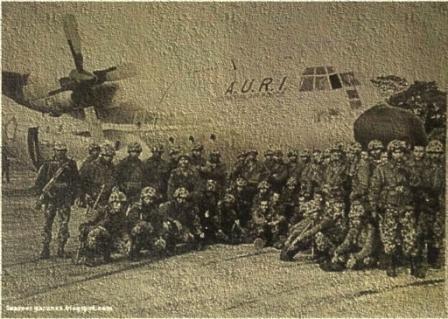In May 1962, a Hercules piloted by Major T.Z. Abidin took off from Ambon Airbase at around 03.30, heading to Teminabuan, West Papua. Soon the 4 Allison T56A-15 C-130B Hercules were run at their maximum speed to reach the elevation beyond the detection of Dutch’s radars and the reach of Neptune planes.
At dawn, a total of 81 paratroopers jumped off from the plane into the darkness. Gliding down silently to the land far below, which they never knew, they immersed in their thinking. They knew nothing about what would be their destiny and what was waiting for them below. Under the breeze that swept their faces, they were aware that they were, in fact, in a one-way ticket mission.
These air infiltrations penetrating directly into the interior of West Papua marked the beginning of the Mandala operation launched under the command of Major General Soeharto to take over the region then still under Dutch occupation. The Mandala Command launched landing activities from the sea and airborne.
A total of ten companies infiltrated to establish the guerrilla basis and front-lines to launch attacks against Dutch Army troops. Those units should be able to develop de facto territorial areas and bring together the local people in the struggle to free the region.
Some of those operations were Banteng (Bull) in Fak-Fak and Kaimana, Serigala (Wolf) around Sorong and Teminabuan, Naga (Dragon) in Merauke, and Jatayu (Eagle) in Sorong, Kaimana, and Merauke. From then on, the units should openly attack the enemy military concentration and occupy the enemy’s essential defense positions. The last step was to strengthen the sovereignty of Indonesia over the whole of West Papua.
Two figures who led the operations then became well known. The Wolf Company in Tanah Merah led by Major Untung Sjamsuri, who then became the leader of the abortive coup d’état known as G30S PKI. The Dragon Company in Merauke led by Major Benny Moerdani later became Minister of Defense/Chief Commander of Armed Forces.
The dense terrain that they encountered made contacts among the fellow raider troops dispersed around the almost impenetrable jungle. They were soon short of food rations and had to survive to utilize leaves, fruits, and edible roots.
To overcome difficult communication among the units, Benny Moerdani and Untung Sjamsuri, for example, finally settled the problems by employing the trained doves. Benny Moerdani could be back home in Jakarta safely after the operation, but Untung and his troops were arrested by Dutch and put in Hollandia Jail. He and his troops were re-sent to Indonesia by the Dutch ship harboring in Tanjung Priok after West Papua became the part of Indonesia in 1963.
One of the troops’ infiltrations through the sea was what would then be known as the Aru Sea Incident. Commodore Jos Soedarso boarding in the KRI Macan Tutul (Jaguar) had bravely protected the remaining escorts by heading in full speed the Dutch warships which intercepted them. He, together with his boat, submerged to the bottom of the sea while the remaining turned around to avoid imbalance battle, and the infiltration mission was abortive.
The massive military operation planned by the Indonesian side under the name of Jayawijaya Operation would inevitably lead to an open war between Indonesia and Netherlands. However, following the survey by U-2 Dragon Lady, US spy airplanes, flying to and fro Darwin-Philippine portraying Indonesian military concentration in Ambon, US government showed the pictures which deterred the Dutch and asked the latter to settle down the dispute peacefully. And so the devastating war between the two countries which nearly broke out was avoided.







